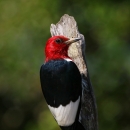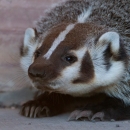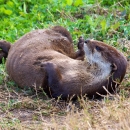Seasons of Wildlife
January
- Chickadees begin to sing, “spring’s here” song
- Listen for downy, hairy, red-bellied and pileated woodpeckers drumming on trees to advertise territory and attract mates
- Look for mouse, vole and bird tracks in the snow
- On warm days look for snow fleas on the snow surface or tracks of skunks that may emerge from winter sleep to look for food
February
- Look for long, linear tracks made by otters sliding in snow
- Listen for courting calls of great horned owls
- Bald eagles court and refurbish their nests
- The crimson stems of red-osier dogwood may show signs of being snipped by rabbits or torn by deer
March
- Bald eagles begin to incubate eggs
- Male red-winged blackbirds, back two weeks before the females, ring the wetlands with their “konk-la-ree” song
- Listen for the bugling of returned sandhill cranes and the honking of Canada geese
- Fuzzy flower catkins open on willows and are visited by many native bees and flies
April
- Listen for the high pitched, bird-like chirping of the spring peeper and the long “cre-e-e-ek” sound of the western chorus frog
- Pasque flowers begin to bloom
- Mourning cloak butterflies wake from hibernation and begin to mate
- First eaglets hatch
- Loons and wood ducks arrive as the ice leaves
- Pocket gophers push soil above ground as they dig tunnels below
- Look for fox sparrows, hermit thrushes and golden-crowned kinglets
- Snakes and turtles bask in sunlight to warm themselves
- Newly returned migrant songbirds are in full song to establish territories and attract mates
- Look along wetland edges for the yellow blossom of marsh marigolds
- Check prairie openings for the red blossom of prairie smoke and woodlands for the white blossom of the wood anemone
May
- Listen for ruffed grouse drumming and turkey gobbling
- Look for tropical birds such as rose-breasted grosbeaks, orioles, warblers and hummingbirds, which come north to nest where insect abundance and longer days of spring and summer allow greater reproduction
- Blanding’s turtle females move to upland nest sites
- Look in wetlands for cattail lodges of muskrats and the wood/mud lodges of beavers
- Look for the gold hue changing to green in the treetops as buds swell, trees flower and branches leaf out
- In prairie openings look for the gold blossom of hoary puccoon. In the woodlands look for the red blossom of columbine and white flowers of false lily of the valley.
- Smell the sweet scent of wild plum, black cherry and choke cherry blossoms
- Listen for the high, even trill of chorusing American toads
- First Canada goose goslings hatch
- Look for white blossoms on dogwood
- Watch for dragonflies, with wings held straight out at rest, and damselflies, with wings held together over their back at rest
June
- Watch for turtles laying their eggs on the sandy edges of the Wildlife Drive
- The purple blossoms of wild lupine and the pink blossoms of wild rose are spectacular on the Wildlife Drive
- Spiders build webs, bees collect nectar from flowers and dragonflies eat mosquitoes during their acrobatic flights
- Loon chicks ride their parent’s back in the wetlands and deer fawns lay hidden in the woods, camouflaged by their dappled coloration
- In prairie openings look for the pink blossoms of common milkweed and the white blossoms of yarrow
- Look along wetland edges for blooming blue flag iris
- Deer flies and other biting insects appear
- Look in the prairie openings for the purple blossoms of hyssop and leadplant and the bright orange flowers of butterfly weed
July
- Common milkweed flowers have a fragrant scent
- Look on plant stems for spittle-bug nests (larval plant-hoppers)
- In prairie openings look for the yellow blossoms of black-eyed Susan and gray-headed coneflower and the purple blossoms of purple prairie clover and prairie phlox. Water lilies are in bloom in the wetlands.
- Look for the purple blossoms of wild bergamot and vervain and the yellow flowers of coreopsis. Listen for the cicada’s high pitch “czzzing” sound.
- Monarch caterpillars feed on common milkweed
August
- Look for the first purple blooms of blazing star and the yellow blossoms of goldenrod
- Look for the “turkey-foot” inflorescence of big bluestem and the golden “headdress” of Indian grass as well as the feathery tufts of little bluestem
- Note the drying of grasses and foliage as the fall color change subtly begins
September
- Watch for flocks of migrating white pelicans spiraling high in the sky
- Migrant monarch butterflies headed for Mexico can be seen sipping nectar at flowers during the day to refuel
- Look for the purple and white blossoms of asters along the Wildlife Drive and the Blue Hill Trail
- Hummingbirds, orioles, warblers, swallows and other migrant birds go south to winter where food is more available
October
- Sandhill cranes gather in numbers to roost in wetlands at night and feed in upland fields by day in preparation for migrating south
- Fall colors are at their peak – maples, sumac, oaks, aspen. Enjoy the beauty!
- See numerous bald eagles and hawks migrating south
- Comma, question mark and mourning cloak butterflies begin hibernation
November
- Sandhill cranes continue on their southerly migration as ice covers the wetlands
- Crows, blue jays, pileated woodpeckers, chickadees, finches, owls, nuthatches and a few hardy robins stay at the refuge through the winter and may be seen on the Blue Hill, Mahnomen and Oak Savanna Learning Center trails
December
- Chipmunks, woodchucks and other hibernators look for dens and burrows
- Deciduous trees, except northern pin and northern red oak, are bare; perennial plants have gone dormant for the winter leaving dried stalks, leaves and maybe some seeds for the birds
Featured Species
Predominately composed of oak savanna, the refuge supports a wide variety of wildlife, ranging from sandhill cranes to bald eagles and badgers to wild lupine. Oak savanna is characterized by scattered bur oak trees with corky bark designed to survive the prescribed fire used to manage this landscape. Under the sparse canopy, wildflowers and grasses abound, with the display of colors and blooms changing weekly in the late spring, summer and early fall. Popular with pollinators, this nectar-rich habitat is often buzzing with activity. Monarch butterflies, eastern tiger swallowtails and brown-belted bumble bees are a sampling of the insects that frequent the flowers. Red-headed woodpeckers nest and raise their young in standing dead oaks, and coyotes and foxes trot through this habitat. Badgers and plains hog-nosed snakes burrow in the sandy soil, and Blanding’s turtles that live in the nearby wetlands lay their eggs in this soft substrate.
The variety of wetlands within the refuge provide food, homes and nesting and nursery grounds to countless species. Sandhill cranes, common loons and trumpeter swans nest on or near wetlands, and they take advantage of the buffet of food within this watery habitat. Great blue herons, sora rails, muskrats and chalk-fronted corporals can be spotted hunting or foraging at the edge of wetlands, often amidst the cover of cattails. In the fall, refuge wetlands provide a safe overnight roost for staging sandhill cranes that are on their southerly migration; at peak, the refuge can host more than 14,000 cranes in the end of October or early November.
The St. Francis River that winds through the refuge provides a corridor of excellent riparian riparian
Definition of riparian habitat or riparian areas.
Learn more about riparian habitat for waterbirds, songbirds and mammals, including river otters, beavers. The river channel is usually free of ice earlier and later in the season than the shallow wetlands, making it a prime spot to spot hooded mergansers, wood ducks and other water-loving species in the early spring.








